1998 PONTIAC BONNEVILLE hood open
[x] Cancel search: hood openPage 80 of 395
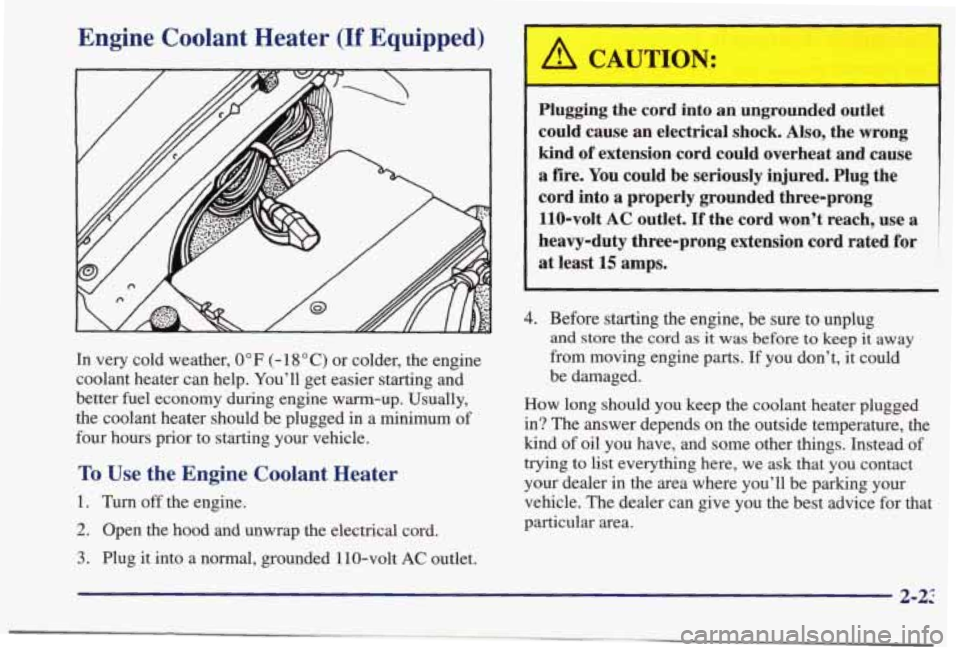
Engine Coolant Heater (If Equipped)
In very cold weather, 0” F (- 18 O C) or colder, the engine
coolant heater can help. You’ll get easier starting and
better fuel economy during engine warm-up. Usually,
the coolant heater should be plugged in a minimum of
four hours prior to starting your vehicle.
To Use the Engine Coolant Heater
1. Turn off the engine.
2. Open the hood and unwrap the electrical cord.
3. Plug it into a normal, grounded 1 10-volt AC outlet.
/1 CAUTION:
Plugging the cord into an ungrounded outlet
could cause
an electrical shock. Also, the wrong
kind of extension cord could overheat and cause
a fire. You could be seriously injured. Plug the
cord into a properly grounded three-prong
110-volt AC outlet.
If the cord won’t reach, use a
heavy-duty three-prong extension cord rated for at least
15 amps.
4. Before starting the engine, be sure to unplug
and store the cord as it was before to keep it away
from moving engine parts.
If you don’t, it could
be damaged.
How long should you keep the coolant heater plugged in? The answer depends
on the outside temperature, the
kind of oil you have, and some other things. Instead of
trying to list everything here, we ask that you contact
your dealer in the area where you’ll be parking your
vehicle. The dealer can give you the best advice for that
particular area.
2-22
Page 148 of 395
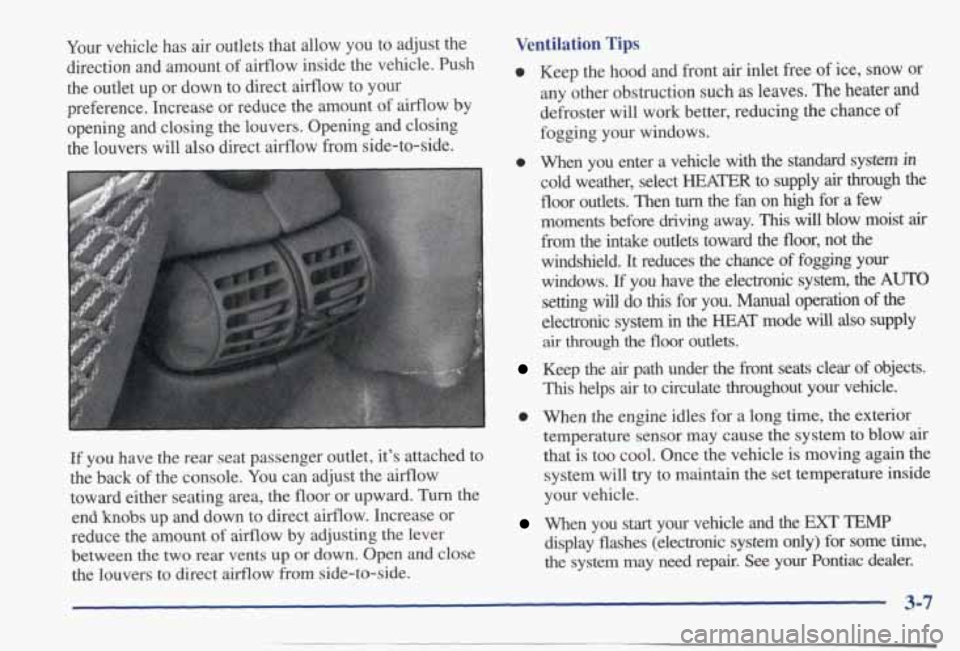
Your vehicle has air outlets that allow you to adjust the
direction and amount of airflow inside the vehicle. Push
the outlet up or down to direct airflow to your
preference. Increase or reduce the amount of airflow by
opening and closing the louvers. Opening and closing
the louvers
will also direct airflow from side-to-side.
If you have the rear seat passenger outlet, it's attached to
the back
of the console. You can adjust the airflow
toward either seating area, the floor or upward. Turn the
end
knobs up and down to direct airflow. Increase or
reduce the amount of airflow by adjusting the lever
between
the two rear vents up or down. Open and close
the louvers to direct airflow from side-to-side.
Ventilation Tips
0 Keep the hood and front air inlet free of ice, snow or
any other obstruction such as leaves. The heater and
defroster will work better, reducing the chance of
fogging your windows.
0 When you enter a vehicle with the standard system in
cold weather, select HEATER to supply air through the
floor outlets. Then turn the fan on high for a few
moments before driving away.
This will blow moist air
from the intake outlets toward the floor, not the
windshield. It reduces the chance
of fogging your
windows. If you have the electronic system, the AUTO
setting will do this for you. Manual operation of the
electronic system in the HEAT mode will also supply
air through the floor outlets.
Keep the air path under the front seats clear of objects.
This helps air to circulate throughout your vehicle.
0 When the engine idles for a long time, the exterior
temperature sensor may cause the system to blow
air
that is too cool. Once the vehicle is moving again the
system
will try to maintain the set temperature inside
your vehicle.
When you start your vehicle and the EXT TEMP
display flashes (electronic system only) for some time,
the system may
need repair. See your Pontiac dealer.
Page 217 of 395
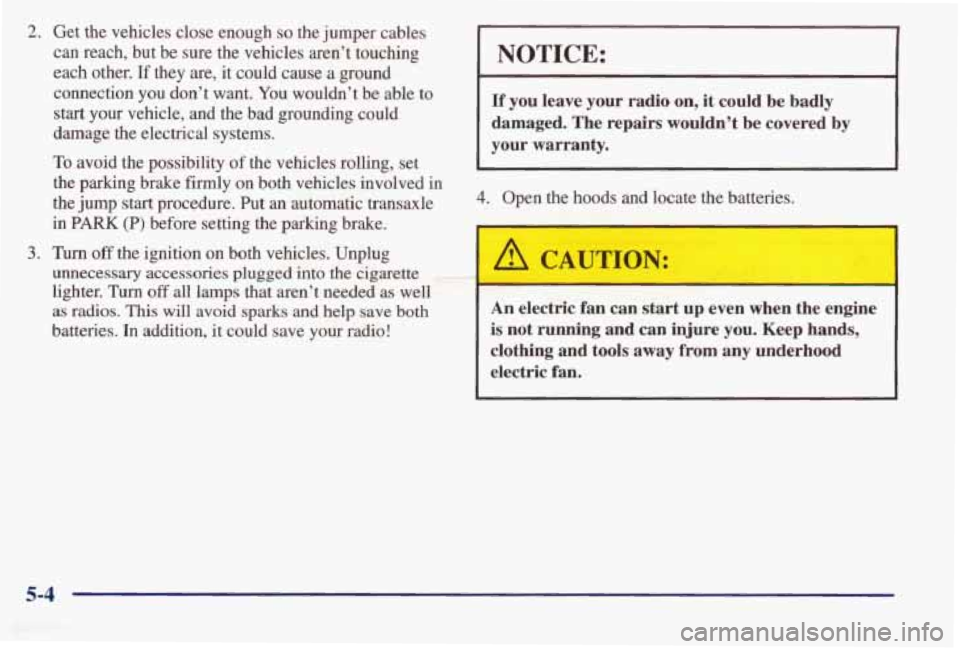
2. Get the vehicles close enough so the jumper cables
can reach, but be sure the vehicles aren’t touching
each other.
If they are, it could cause a ground
connection you don’t want. You wouldn’t be able to
start your vehicle, and the bad grounding could
damage the electrical systems.
To avoid the possibility of the vehicles rolling, set
the parking brake
fiiy on both vehicles involved in
the jump
start procedure. Put an automatic transaxle
in PARK (P) before setting the parking brake.
3. Turn off the ignition on both vehicles. Unplug
unnecessary accessories plugged into the cigarette
I NOTICE:
If you leave your radio on, it could be badly
damaged. The repairs wouldn’t be covered by
your warranty.
4. Open the hoods and locate the batteries.
A CAUTION:
lighter. Tu& off all lam@ that aren’t needed as well
as radios. This will avoid sparks and help save both An electric fan can start up even when the engine
batteries. In addition, it could save your radio! is not running and can injure you. Keep hands,
clothing and tools away
from any underhood
electric fan.
5-4
Page 228 of 395
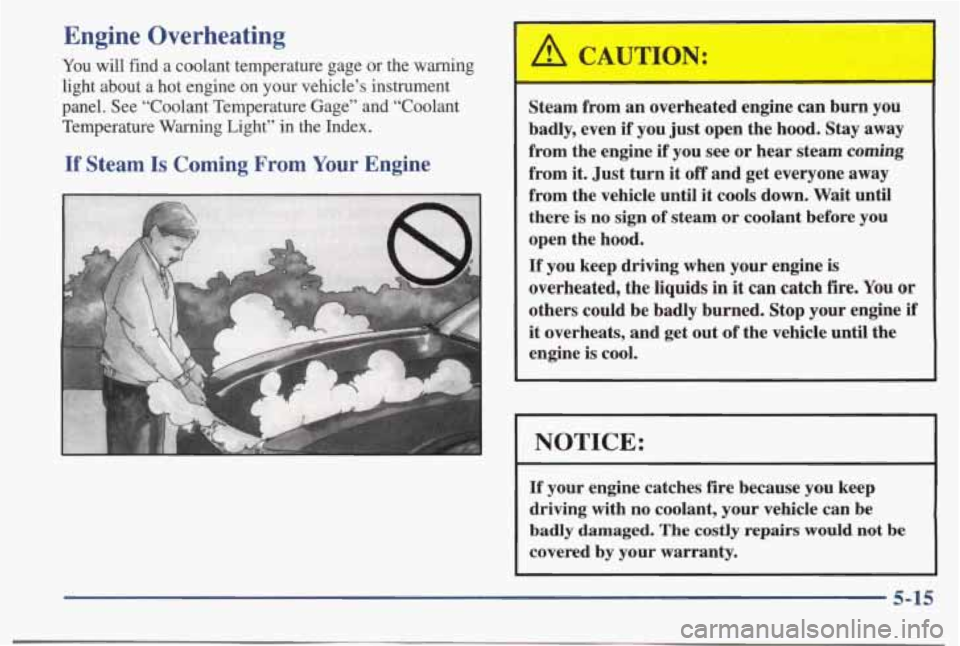
Engine Overheating
You will find a coolant temperature gage or the warning
light about a hot engine on your vehicle’s instrument
panel. See “Coolant Temperature Gage” and “Coolant Temperature Warning
Light” in the Index.
If Steam Is Coming From Your Engine
1
A CAUTION:
Steam from an overheated engine can burn you
badly, even if you just open the hood. Stay away
from the engine if you see or hear steam
coming
from it. Just turn it off and get everyone away
from the vehicle until it cools down. Wait until
there is no sign
of steam or coolant before you
open the hood.
If you keep driving when your engine is
overheated, the liquids in it
can catch fire. You or
others could be badly burned. Stop your engine if
it overheats, and get out of the vehicle until the
engine is cool.
I
NOTICE:
If your engine catches fire because you keep
driving with no coolant, your vehicle can be
badly damaged. The costly repairs would not be
covered by your warranty.
5-15
Page 229 of 395
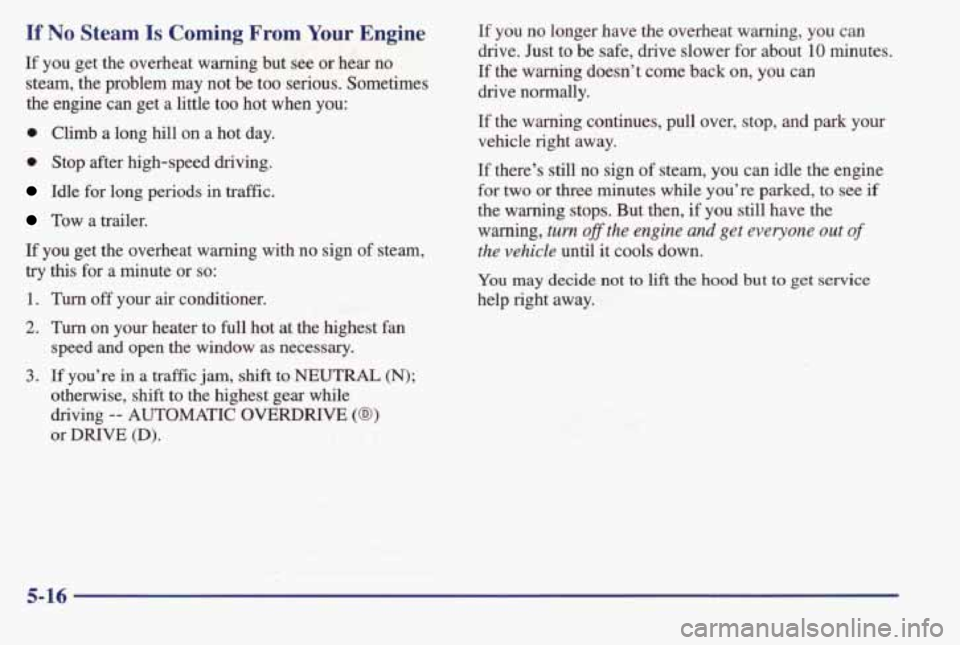
If No Steam Is Coming From Your Engine
If you get the overheat waming but see or hear no
steam, the problem may not be too serious. Sometimes the engine can get a little too hot when you:
0 Climb a long hill on a hot day.
0 Stop after high-speed driving.
Idle for long periods in traffic.
Tow a trailer.
If you get the overheat warning with no sign of steam,
try this for a minute or so:
1. Turn off your air conditioner.
2. Turn on your heater to full hot at the highest fan
speed
and open the window as necessary.
3. If you’re in a trafEc jam, shift to NEUTRAL (N);
otherwise, shift to the highest gear while
driving
-- AUTOMATIC OVERDRIVE (@)
or DRIVE (D).
If you no longer have the overheat warning, you can
drive. Just to be safe,
drive slower for about 10 minutes.
If the warning doesn’t come back on, you can
drive normally.
If the warning continues, pull over, stop, and park your
vehicle right away.
If there’s
still no sign of steam, you can idle the engine
for two or three minutes while you’re parked, to see if
the warning stops. But then, if you still have the
warning,
turn oflthe engine and get everyone out of
the vehicle until it cools down.
You may decide not to lift the hood but to get service
help right away.
5-16
Page 255 of 395
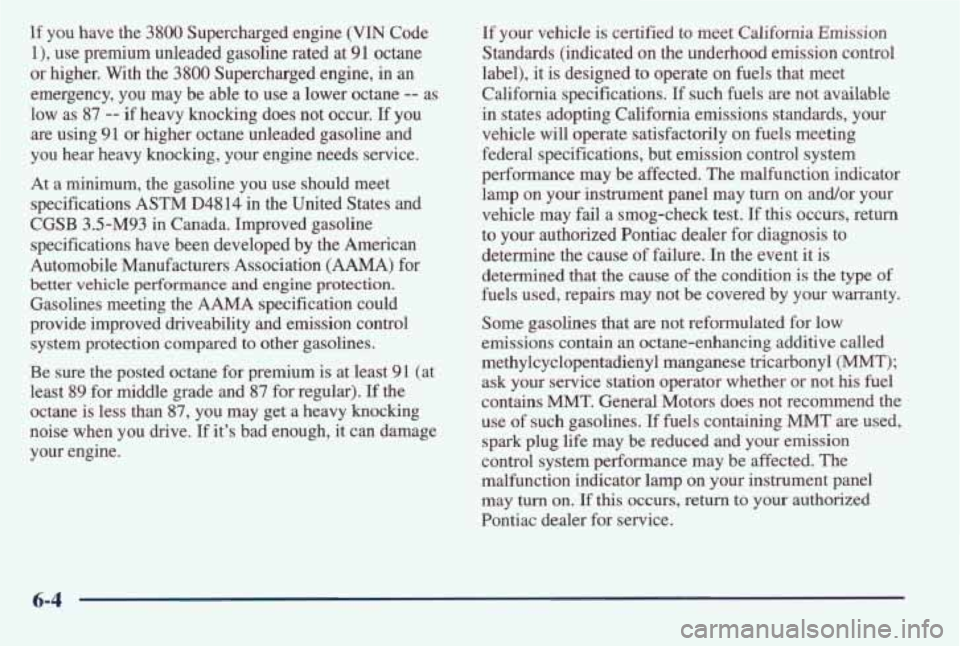
If you have the 3800 Supercharged engine (VIN Code
l), use premium unleaded gasoline rated at 91 octane
or higher. With the
3800 Supercharged engine, in an
emergency, you may be able to use a lower octane -- as
low as
87 -- if heavy knocking does not occur. If you
are using
91 or higher octane unleaded gasoline and
you hear heavy knocking, your engine needs service.
At a minimum, the gasoline you use should meet specifications
ASTM D4814 in the United States and
CGSB 3.5-M93 in Canada. Improved gasoline
specifications have been developed by the American
Automobile Manufacturers Association
(AAMA) for
better vehicle performance and engine protection.
Gasolines meeting the AAMA specification could
provide improved driveability and emission control
system protection compared to other gasolines.
Be sure the posted octane for premium is at least
91 (at
least
89 for middle grade and 87 for regular). If the
octane is less than
87, you may get a heavy knocking
noise when you drive. If it’s bad enough, it can damage
your engine.
If your vehicle is certified to meet California Emission
Standards (indicated
on the underhood emission control
label), it is designed to operate on fwels that meet
California specifications. If such fuels are not available
in states adopting California emissions standards, your vehicle will operate satisfactorily
on fuels meeting
federal specifications, but emission control system
performance may be affected. The malfunction indicator lamp on your instrument panel may
turn on and/or your
vehicle may fail a smog-check test. If this occurs, return
to
your authorized Pontiac dealer for diagnosis to
determine the cause of failure.
In the event it is
determined that the cause of the condition
is the type of
fuels used, repairs
may not be covered by your warranty.
Some gasolines that are not reformulated
for low
emissions contain
an octane-enhancing additive called
methylcyclopentadienyl manganese tricarbonyl
(MMT);
ask your service station operator whether or not his fuel
contains
MMT. General Motors does not recommend the
use of such gasolines. If fuels containing MMT are used,
spark plug life may be reduced and your emission
control system performance may be affected. The
malfunction indicator lamp
on your instrument panel
may
turn on. If this occurs, return to your authorized
Pontiac dealer for service.
6-4
Page 260 of 395
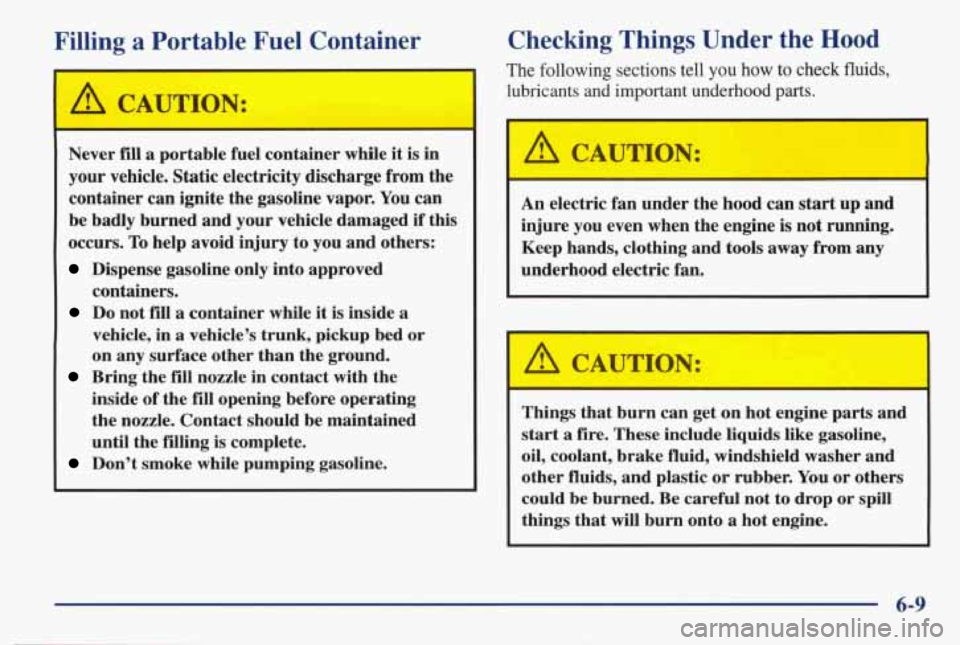
Filling a Portable Fuel Container
I
1 A CAUTION: I
Never fill a portable fuel container while it is in
your vehicle. Static electricity discharge from the
container can ignite the gasoline vapor. You can
be badly burned and your vehicle damaged
if this
occurs. To help avoid injury to you and others:
Dispense gasoline only into approved
containers.
Do not fill a container while it is inside a
vehicle, in a vehicle’s trunk, pickup bed or
on any surface other than the ground.
inside of the fill opening before operating
the nozzle. Contact should be maintained
until the ring
is complete.
Bring the fill nozzle in contact with the
Don’t smoke while pumping gasoline.
Checking Things Under the Hood
The following sections tell you how to check fluids,
lubricants and important underhood parts.
A CAUTION:
I
An electric fan under the hood can start up and
injure you even when the engine
is not running.
Keep hands, clothing and tools away from any
underhood electric fan.
A CAUTION:
Things that burn can get on hot engine parts and
start a fire. These include liquids like gasoline,
oil, coolant, brake fluid, windshield washer and
other fluids, and plastic or rubber. You or others
could be burned. Be careful not to drop or spill
things that
will burn onto a hot engine.
I
6-9
Page 261 of 395
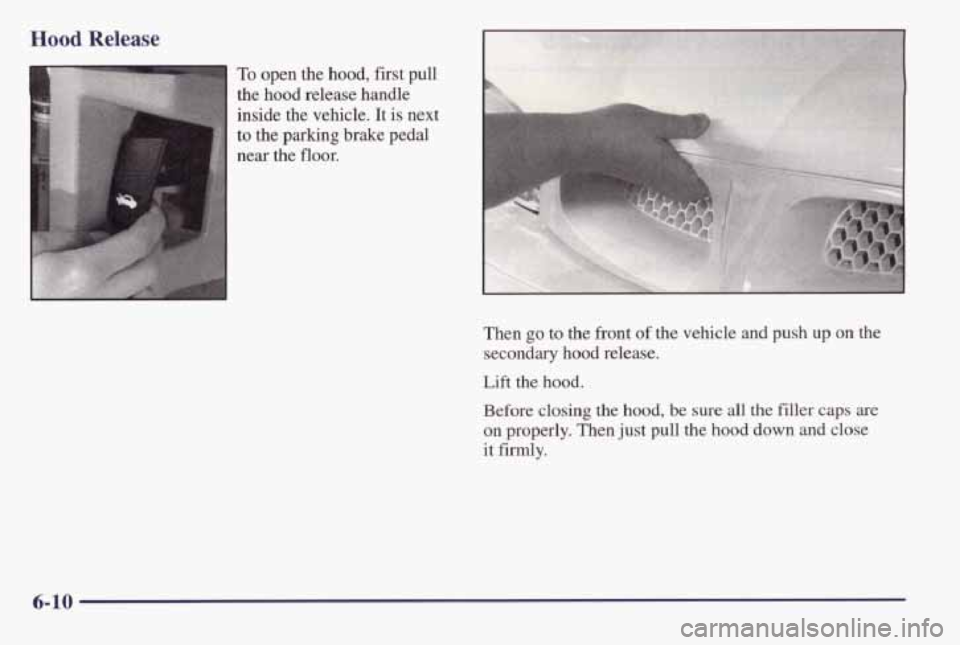
Hood Release
To open the hood, fist pull
the hood release handle
inside
the vehicle. It is next
to the parking brake pedal
Then
go to the front of the vehicle and push up on the
secondary hood release.
Lift the hood.
Before closing
the hood, be sure all the filler caps are
on properly. Then just pull the hood down and close
it firmly.
6-10